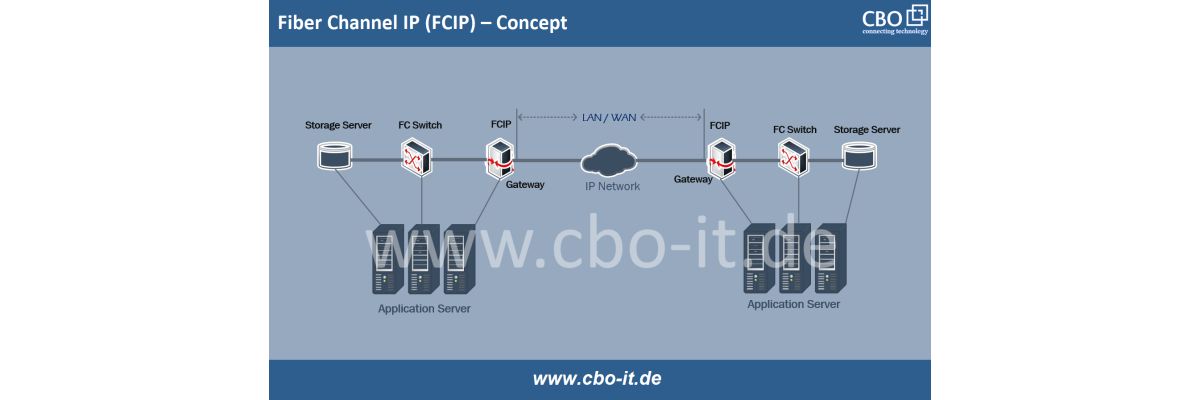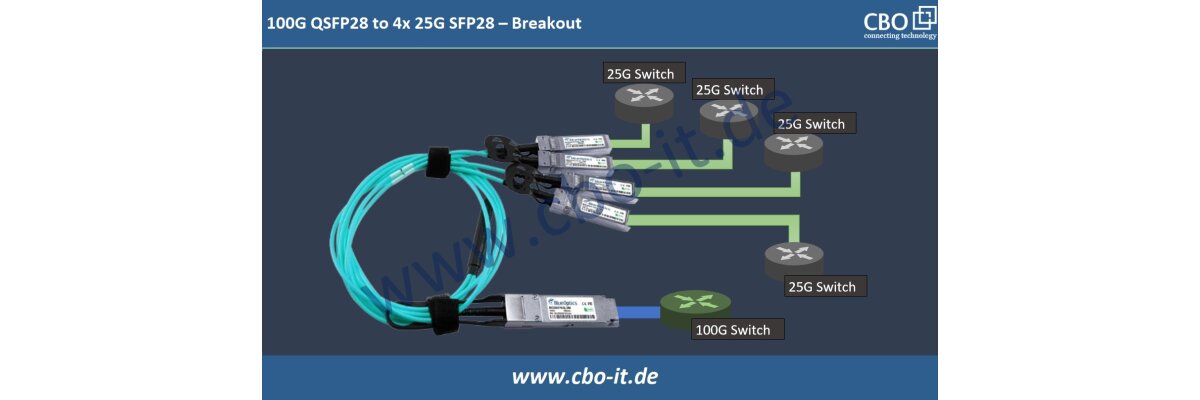Migration to 400G - Challenges & Solutions!
The rapid surge in demand for bandwidth has pushed data center operators to massive upgradations. There was a time when 10G was popular. Later, 40G replaced the 10G. These days, 100G is one of the most widely used technology. However, 400G is now officially available, and the IEEE is working on 800G. Many data center operators have already started their quest of migration towards 400G, and some are still confused. There are specific challenges involved in this sort of up-gradation. Today, we have decided to provide our readers with some vital information about 40, 100 or 200G to 400G migrations.
40G/100G to 400G Migration Challenges
Well, the 400G is a newer technology, and its backward compatibility with the already existing internetworking infrastructure is an issue. As we all know, completely different form-factors (QSFP-DD, OSFP, CFP8, etc.) are developed for 400G. Unfortunately, OSFP does not support backward compatibility as it is broader and longer than the QSFP.
In terms of backward compatibility, the 400G QSFP-DD is a better choice as QSFP-DD ports are designed to support 100G and 40G pluggable transceivers. Luckily, swift migrations are still possible as we have some great resources available on the market and today we have decided to discuss a few of them. Here, it is essential to know that the CFP8 is not a popular choice because of its extraordinarily larger size.
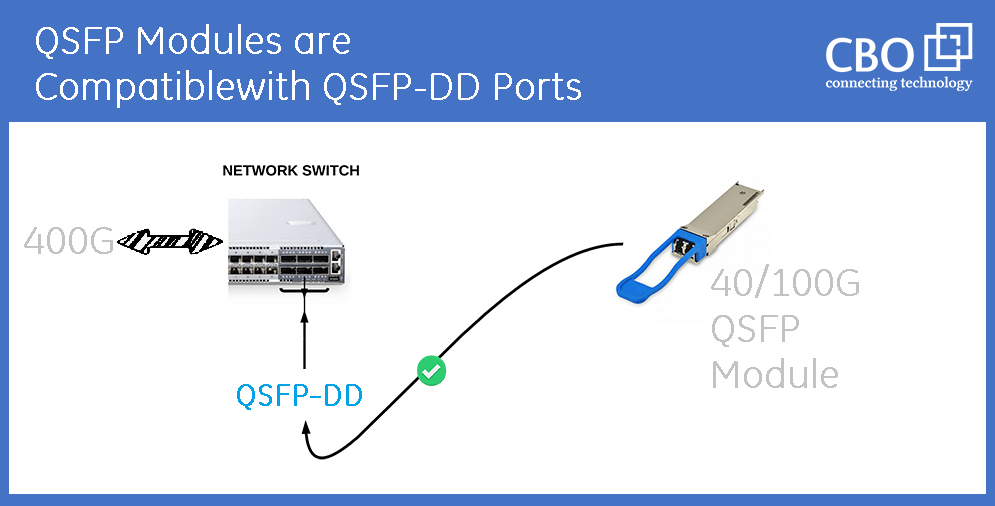
QSFP-DD Ports Backward Compatibility
As mentioned earlier, a 40G QSFP or 100G QSFP module can be inserted into any QSFP-DD port. In this arrangement, no mechanical adapter is required. However, the QSFP-DD port must be configured appropriately (set the data rate to 40G or 100G as required) as it won’t support 400G in this scenario.
How to Use a QSFP Module in an OSFP Port?
40G or 100G QSFP modules cannot be plugged into an OSFP port directly. It is because of some design features that OSFP ports have. However, this arrangement is possible with the help of a completely passive mechanical adapter.
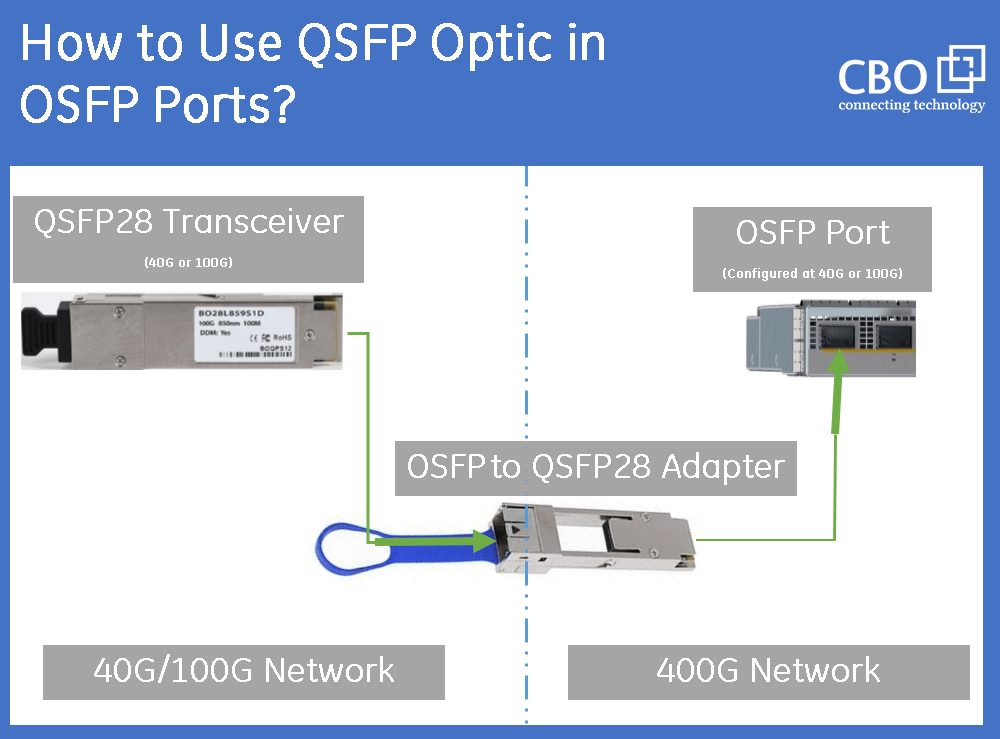
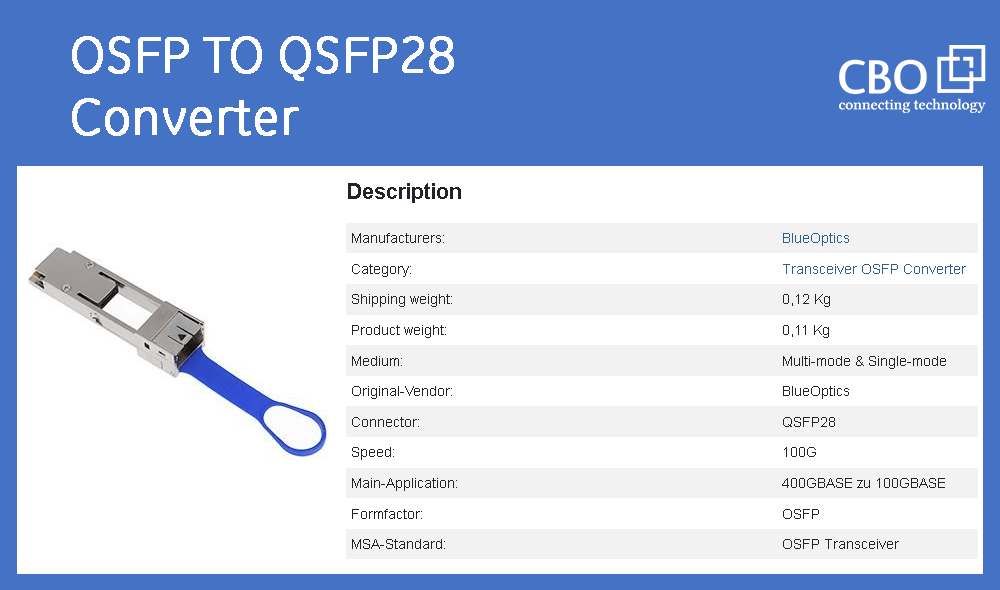
This adaptor can help the users in catering with backward compatibility restrictions of the OSFP. CBO is offering an MSA compliant OSFP to QSFP28 adapter or converter (Item Number: BO-OSFP-QSFP28). This converter can be deployed to convert any 400G OSFP port into a 100G QSFP28 Port. Remember! In this arrangement, OSFP port cannot be operated at 400G data rate. It should have been reconfigured for a data rate of 100G. The OSFP to QSFP28 adapter is an ideal solution for those who are looking to upgrade their high-speed networks.
400G to 40G/100G Direct Attach Breakout Cables
Direct-attach breakout cables are available in various configurations. These cables allow splitting of 400G bandwidth into multiple 100G or 40G data streams. In this way, a single OSFP or QSFP-DD port can be connected with multiple QSFP28 ports. One end of these cables (say Connector A) comes with an OSFP connector. Whereas the other end (say connector B) comes with multiple QSFP28, SFP56 or QSFP56 connectors. Direct Attach type breakout cables use the copper cable for transmission of data. Thus, these cables are suitable for short-distance applications only.
With these cables, 400G bandwidth can be distributed in multiple streams of 100G, 200G or 50G bandwidths. Here, it is important to understand that the passive direct-attach breakout cables do not contain signal conditioning electronics. Hence, using passive cables is not recommended when you switch does not support signal conditioning. In cases where signal conditioning is required, only active direct-attach breakout cables should be used. CBO is offering a comprehensive range of Direct Attach Breakout Cables in following variations.
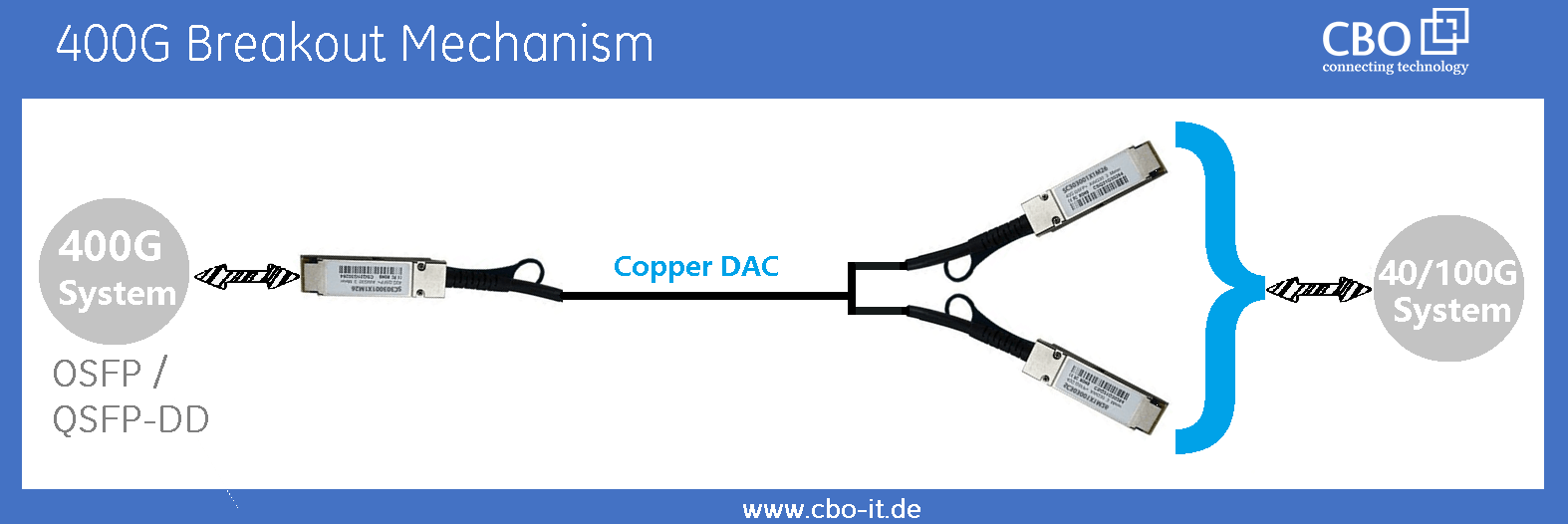
OSFP Direct Attach Breakout Cables (Passive)
- 400GBASE-CR8 OSFP To 4 X QSFP28 (400G to 4 x 100G)
- 400GBASE-CR8 OSFP To 8 X SFP56 (400G to 8 x 50G)
- 400GBASE-CR8 OSFP To 2 X QSFP56 (400G to 2 x 200G)
QSFP-DD Direct Attach Breakout Cables (Passive)
- 400GBASE-CR8 QSFP-DD To 4 X QSFP28 (400G to 4 x 100G)
- 400GBASE-CR8 QSFP-DD To 8 X SFP56 (400G to 8 x 50G)
- 400GBASE-CR8 QSFP-DD To 2 X QSFP56 (400G to 2 x 200G)
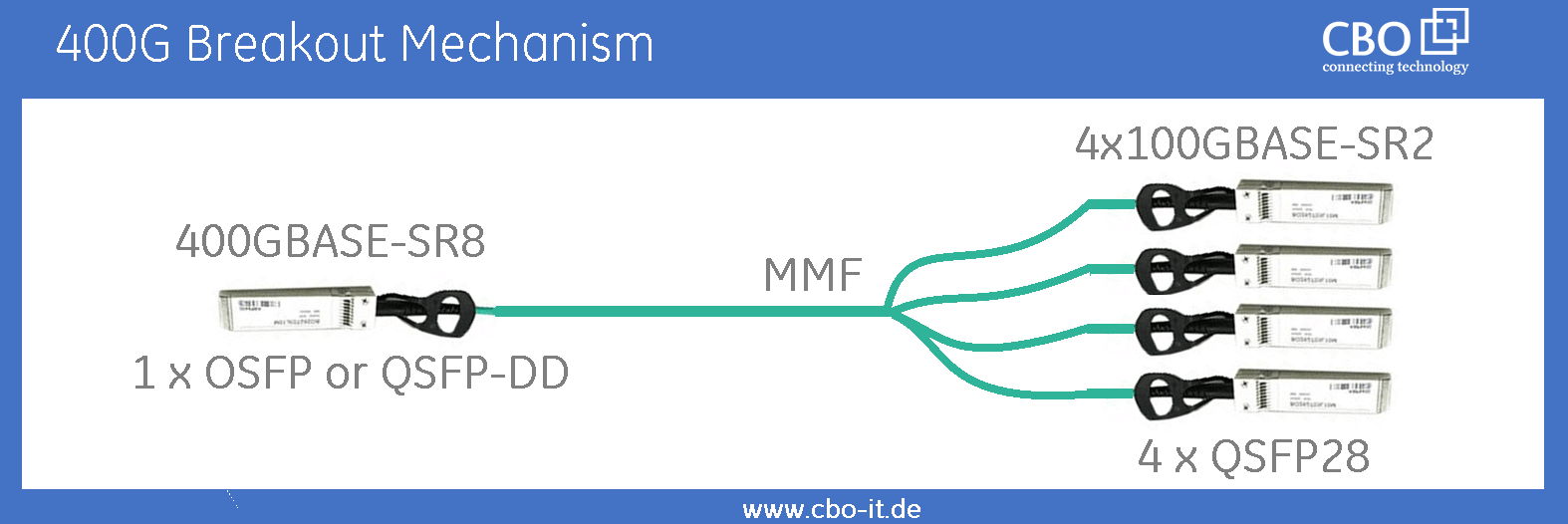
400G to 40G/100G/200G Active Optical Breakout Cables
Unlike direct attach cables, fiber is used as a transmission medium in active optical cables. Therefore, more link distance is possible in this breakout arrangement. One end of these cables come with a 400G transceiver. Whereas multiple 40G or 100G transceivers are provided at the other end. Thus, 400G Active Optical Breakout Cables works as a bridge between 400G and 40G/100G/200G networks. These cables come with Digital Optical Monitoring (DOM) and Digital Diagnostics Monitoring (DDM) interface. Thus, user can access all the critical parameters including; Laser Bias Current, Supply Voltage, Laser Received Input Power and Laser Average Output Power on a real-time basis.
400G Active Optical Breakout Cables come with integrated electronics and can offer transmission over longer distances. However, these cables consume much more power than direct-attached cables. CBO is offering a comprehensive range of 400G Active Optical Breakout Cables. Following is a short summarization of their products portfolio:
OSFP Active Optical Breakout Cables
- 400GBASE-SR8 OSFP to 4 x QSFP28 (400G to 4 x 100G)
- 400GBASE-SR8 OSFP to 8 x SFP56 (400G to 8 x 50G)
- 400GBASE-SR8 OSFP to 2 x QSFP56 (400G to 2 x 200G)
QSFP-DD Active Optical Breakout Cables
- 400GBASE-SR8 QSFP-DD to 4 x QSFP28 (400G to 4 x 100G)
- 400GBASE-SR8 QSFP-DD to 8 x SFP56 (400G to 8 x 50G)
- 400GBASE-SR8 QSFP-DD to 2 x QSFP56 (400G to 2 x 200G)
Conclusion:
Datacenter operators planning to 400G are prone to various challenges. However, we have plenty of solutions available now. QSFP-DD backward compatibility and the availability of various breakout cables are allowing consumers for a seamless and less complicated up-gradation. In addition to the hot-pluggable Active Optical Breakout Cables are available for the online alteration of network routes. Keeping in view the pace at which the internet is growing up-gradation to 400G seems inevitable.
 English
English
 Deutsch
Deutsch
 Espaniol
Espaniol






